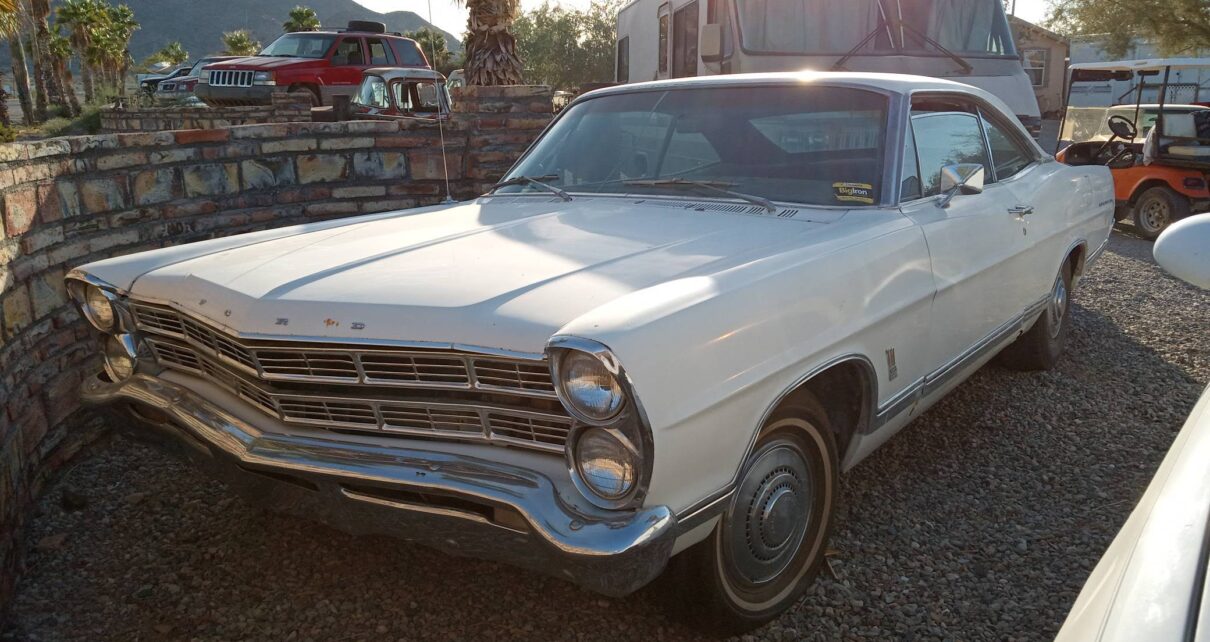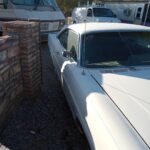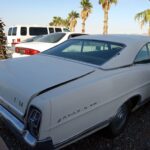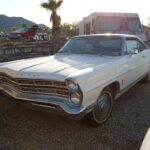The History of the Ford Galaxie
The Ford Galaxie, first introduced in the late 1950s, received an all-new design entering the 1965 model year, becoming taller and bulkier than the previous year’s design, with vertically stacked dual headlights, new instrument panel, and a redesigned rear suspension.
The new top-of-the-line trim designation was the Galaxie 500 LTD and Galaxie 500 XL. The prior leaf-spring rear suspension was redesigned with a new three-link system, with coil springs. A new two-way key vehicle access was introduced, with one intended for valet parking, with the square key only unlocking the doors and the ignition while the other (a round key) would unlock the trunk or glove compartment.
The Ford Galaxie was an intermediate trim level, priced slightly higher than the base Ford Custom (offered in both six and eight-cylinder configuration), Custom 500 Series, Fairlane, Falcon, and Futura, and less than the Thunderbird. 1966 brought the introduction of the Galaxie 500 7 Litre powered by the 428 cubic-inc (7.0 liter) Thunderbird V8 delivering 345 horsepower.
The LTD dropped the Galaxie name, a parking brake light on the dashboard and an AM/FM radio was optional, and the Galaxie 500 raked #3 selling convertible in the United States. Seat belts became standard to comply with new safety regulations for 1966 requiring all new cars to be equipped with this feature. For 1967, the 7 Litre name was no longer used on the Galaxie, becoming a trim and performance option on the Ford XL, which was now a separate model.
All Fords received a large, padded hub in the center of the plastic steering wheel and an energy-absorbing steering column that was introduced late in the 1967 model year. Padding was added to interior surfaces, front outboard shoulder belt anchors were added, and controls were recessed on the instrument panel. A dual brake master cylinder became standard on all Galaxies and other Ford models.
The base engine was an overhead-valve, six-cylinder unit displacing 240 cubic-inches with seven main bearings, a Holley one-barrel carburetor, and delivering 150 horsepower at 4,000 RPM. Ford’s list of V8s included 289, 390, 427, and 428 CID options in various states of tune depending on configuration, with horsepower ranging from 200 to over 600 hp.
During the 1960s, Ford conducted a global advertising campaign of Total Performance highlighted by successes in a variety of motorsport venues, including the Ford GT40 that won overall in the 24 Hours of Le Mans in 1966, 1967, 1968, and 1969. Numerous victories were earned in other endurance races such as the 12 Hours of Sebring and 24 Hours of Daytona. the big-block 427 engine and the Ford-sponsored Cosworth DFV powered many vehicles to hundreds of victories in CART, NASCAR, Formula One, and other racing series.
Ford-powered Lolas raced in the Can-Am series, and other vehicles such as the Ford Escort were successful in rallying. In keeping with this Total Performance image, the production vehicles were stylistically modified in line with this image, with aggressive persona’s and squared-off looks, backed by a potent list of engine choices.
The 427 cubic-inch Thunderbird Super High-Performance V8, with a two Holley four-barrel carburetor, delivered 425 horsepower at 6,000 RPM. The 428 CID V8 Thunderibrd Special V8 had 345 horsepower, and the 427 CID with Hemispherical combustion chambers with overhead valves and overhead camshafts for each engine back, delivered over 600 horsepower.
This engine was only available ‘over the counter’ for $2,500. In comparison, this was more than a Ford Falcon, Ford Futura, or six-cylinder Fairlane 500. With two Holley four-barrel carburetors, the SOHC 427 V8 engine delivered over 650 horsepower. Body styles on the 1967 Ford Galaxie 500 included a sedan, fastback coupe, fastback sedan, and convertible.
The sedan had a factory price of $2,730, the fastback coupe of $2,750, the fastback sedan at $2,800, and the convertible at $3,000. The name ‘Galaxie 500’ was located on the rear fenders in block letters and the Ford crest was located on the trunk lid above the aluminum trim panel. Aluminum molding rang along the bodyside, and chrome was used around the window moldings, windshield, and horn ring. Simulated woodgrain appliques were used for the instrument panel and inner door panels. A stamped aluminum trim panel could be found on the vertical section of the trunk lid.
The grille was a new double-stamped aluminum piece with horizontal bars divided by five vertical bars and flanked on either side by vertically stacked, double round headlights. The center of the grille pointed forward, mimicked by the hood and bumper. In the back were vertically situated rectangular lights with chrome moldings and chrome cross-hairs surrounding the back-up lights. The sporty Galaxie 500XL was offered in either two-door fastback coupe configuration or convertible with the base engine being the 289 CID V8, with overhead valves, a Holley two-barrel carburetor, five main bearings, and delivering 150 horsepower at 4,000 RPM. With a Holley four-barrel carburetor, horsepower rose to 225 hp at 4,800 RPM.
The High-Performance 289 V8 version of the 289 CID used a Holley four-barrel carburetor and slightly higher compression to deliver 271 horsepower.The Galaxie 500XL came standard with the SelectShift Cruise-O-Matic automatic, bucket seats, front console, automatic courtesy and warning lights in the door panels, chrome trim on the foot pedals, and special ornamentation.
The fastback coupe had a base price of $3,240 and the convertible at $3,500. 18,174 examples of the fastback coupe were built and 5,161 of the convertible. The Ford LTD was the top trim level full-size model and was now its own series for the first time since its introduction in 1965.
Along with the performance options, convenience options included air conditioning, tinted windshield, AM/FM radio, vinyl roof, white sidewall tires, power brakes, and power steering. Total Galaxie production for 1967 included 403,606 examples of the Galaxie 500 and 23,335 of the Galaxie 500XL, for a total of 426,941 units.
by Daniel Vaughan | Nov 2020






